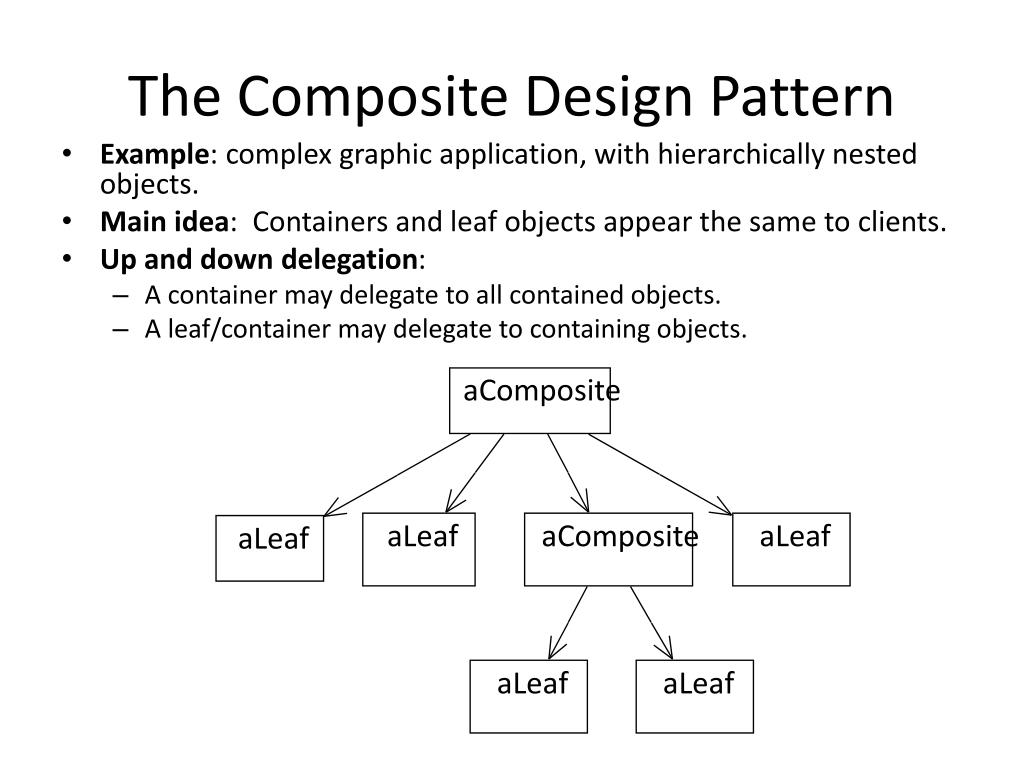Table Of Content

The client uses the component class interface to interact with objects in the composition structure. If the recipient is a leaf then the request is handled directly. If the recipient is a composite, then it usually forwards the request to its child components, possibly performing additional operations before and after forwarding. Another advantage of the Composite Pattern is the flexibility and simple extendibility that the pattern gives a software.
Source code and design conformance, design pattern detection from source code by classification approach - ScienceDirect.com
Source code and design conformance, design pattern detection from source code by classification approach.
Posted: Fri, 11 Oct 2019 05:39:09 GMT [source]
Facade Design Pattern: Streamlining Complexity in Code

The key concept is that you can manipulate a single instance of the object just as you would manipulate a group of them. The operations you can perform on all the composite objects often have the least common denominator relationship. The CompoundGraphic class is a container that can comprise any number of sub-shapes, including other compound shapes. However, instead of doing something on its own, a compound shape passes the request recursively to all its children and “sums up” the result.
Source Code Implementation
Remember, by the way, that eachpattern's structure diagram doesn't define the pattern; it merelydepicts what in our experience is a common realization thereof. Justbecause Composite's structure diagram shows child management operationsin the Component base class doesn't mean all implementations of thepattern must do the same. However, this choice costs you safety, becauseclients may try to do meaningless things like add and remove objectsfrom leaf objects.
UML class and object diagram
The only difference in these implementations are the use of the addParent() and addChild() to create the hierarchy like we can see the following example and the output it will produce. When we want to implement the same interface on leaves and composites so that they are handled in the same way. A Pentalog account allows convenient access to our global price catalog featuring competitive prices for top software engineering and digital profiles. The Composite design pattern emphasizes uniformity over type safety.
The Client code works with all components (IOrganizationComponent) through the single interface common to all of them. Thus, the Client doesn’t know whether it’s working with a simple component or a compound one. The Client can work with very complex object structures without being coupled to concrete classes that form that structure. Like the Facade Pattern and the Decorator Pattern, it is a design pattern which compounds objects and classes into larger structures.
The OrganizationalUnit class is a container that can comprise any number of Employees, and other OrganizationalUnits. An OrganizationalUnit and a simple Employee implements the same methods (declared in IOrganizationComponent). However, instead of doing something on its own, an OrganizationalUnit passes the request recursively to all its children and “sums up” the result.
Related Patterns:
The following class diagram using the graphical notation UML visualizes connections and hierarchies of a software Composite Pattern more clearly. Composite leaves also have a choice of modifying the request/response either before or after the request is handled by leaf node. Smalltalk implementations of the Composite pattern usually do not havethe interface for managing the components in the Component interface,but in the Composite interface. This is an extremely interesting fact, andone that I often ponder. I can offer theories to explain it, butnobody knows for sure why it is true. AddChild(), removeChild()] shouldnormally be defined in the Composite class.
Composite Design Pattern Leaf Objects
Composite is a structural design pattern that allows us to treat individual objects and compositions of objects uniformly. Dynamic data structures require a clear and concise hierarchical structure. Care must be taken that the type of object is not queried every time before the actual data is processed because this would not be efficient. Using a Composite Design Pattern is recommended when many primitive objects meet composite objects.

Structural Software Design Patterns in Java
To resolve the issue, I introduce an interface which is implemented by the single element as well as the class hiding the collection of those elements. The purpose of the composite class is then to contain all the aggregate functions that used to be in the client class. You need to represent various graphic elements, such as circles and squares, and also composite elements, like groups of circles and squares forming a complex scene. Without the Composite Pattern, you might be tempted to represent individual and composite graphics with separate interfaces, leading to code that treats them differently. Despite its potential disadvantages, the Composite Design Pattern remains a valuable tool when dealing with hierarchical structures in software.
Using the Composite pattern makes sense only when the core model of your app can be represented as a tree.
In this example, the client code treats individual graphics and composite graphics uniformly through the Graphic interface, making the code more elegant and extensible. The Composite Pattern eliminates the need for explicit type-checking and simplifies the representation of part-whole hierarchies in a graphic rendering system. This common interface, or Component, defines operations that may be performed on both types of objects, allowing clients to treat them interchangeably. A Composite is a pattern that is useful anytime you may need to selectively treat a group of objects that are part of a hierarchy as "the same" when they are in fact different. Typically the examples used talk in terms of treating leaves and nodes the same, but the pattern can also be extended to heterogeneous lists.
Composites hide the complexity involved in the collections, i.e. looping through them, sorting them out, filtering some etc. and allows you to treat it as if it is a single organism. Common thing here is that Composite is not necessarily representing the part-whole relationship. It is possible to introduce composite element just to move the loops out of the client.
Energy absorption and failure pattern of hybrid composite tubes under quasi-static axial compression - ScienceDirect.com
Energy absorption and failure pattern of hybrid composite tubes under quasi-static axial compression.
Posted: Thu, 01 Oct 2020 07:00:00 GMT [source]
The draw method is uniformly applied, whether the graphic is an individual element or a composite structure. This not only simplifies the client code but also allows for the creation of complex scenes by combining individual and composite graphics seamlessly. You may find it being-a-must when you will be working with binary trees or other complex data structures like list of lists of lists - etc... Then, when every element (class) implements 1 interface, you can do the same methods on 1 leaf or on whole group of them - copping, adding, removing, moving... Subsequently, two simple leaf classes “FinancialDepartment” (for the finance department) and “SalesDepartment” (for the sales department) are defined.
Using the Composite pattern only makes sense when the core model of your application can be represented as a tree. Save on our most popular products, including cloud storage, hosting, websites, servers and more. Directories that contain files, each of which could be a directory. First we need to declare the interface that will describe the behavior of our component.
Use the pattern when you want the client code to treat both simple and complex elements uniformly. The Composite design pattern helps us constructing complex structures from simpler ones; in other words, we can use small structures to assemble a bigger and more complex structure. The Composite Pattern is probably best established in the Java programming language. The pattern forms the basis of the Abstract Window Toolkit (AWT), among other things. AWT is a practical and popular API with around 50 ready-to-use Java classes for the development of cross-platform Java interfaces. In the code example that follows – taken from the blog entry “Composite Design Pattern in Java” on baeldung.com – we’ve focused on the popular programming language.
Pentalog Connect is your free pass to a large community of top engineers who excel in developing outstanding and impactful digital products. When joining, you receive access to a wealth of resources that will feed your appetite for quality content and your need for professional growth. This C++14 implementation is based on the pre C++98 implementation in the book. Above can be easily implemented using Composite Design pattern. So, for you, a Dog is an IDog, who Feed(), Bark(), Vomit() and GetVaccine(). It may have a time keeping mechanism to follow each dog's feeding and other bodily function times.

No comments:
Post a Comment